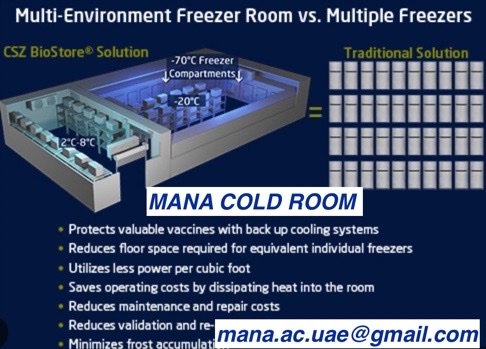Industrial Cold Rooms
Mana Cold Room Manufacture Specializes in the design, installation, and maintenance
of cold storage rooms, refrigeration systems and commercial / industrial refrigeration equipment. It has about 20 years of experience in the refrigeration industry in UAE.
Mana is a professional manufacturer of refrigeration equipment that integrates research and development, design, production and sales together. It is a high-tech enterprise specializing in intelligent energy-saving cold storage planning, design and research; system integration and control; manufacturing, installation and commissioning; project contracting and management; and technical support services
.
commercial cold room manufacture - industrial cold room supplier
An industrial cold room is a temperature-controlled space used for the storage of perishable goods such as food, pharmaceuticals, chemicals, and other items requiring specific temperature conditions. Designing and operating a cold room for industrial use involves several key considerations to ensure it meets the necessary requirements for efficiency, safety, and compliance with industry standards.
Key Requirements for Industrial Cold Rooms
1. Temperature Control and Range
-
Temperature Range:
The cold room's temperature depends on the products being stored. Common ranges include
- Chilled Storage: 0°C to 4°C (for items like dairy, fresh vegetables, meats).
- Freezer Storage: -18°C to -25°C (for frozen foods and pharmaceuticals).
- Precision Control: The system must maintain precise temperature control with minimal fluctuations, as this can impact the quality and safety of stored products.
2. Insulation
-
High-Quality Insulation: Cold rooms require high-performance thermal
insulation to prevent heat ingress and to maintain the desired temperature.
Common materials include:
- Polyurethane (PUR) or Polyisocyanurate (PIR) panels for better thermal efficiency.
- Thickness of insulation: Typically ranges from 80mm to 200mm, depending on the application and temperature range.
- Seals and Gaskets: Proper sealing around doors and walls is crucial to maintaining temperature control.
3. Refrigeration System
-
Type of Refrigeration: Industrial cold rooms typically use either:
- Direct Expansion (DX) System: Often used for smaller cold rooms.
- Centralized Chilled Water Systems: Suitable for larger facilities or multiple cold rooms.
- Compressor: A high-efficiency compressor is needed to provide the cooling power. It should be capable of running continuously for long periods and have energy-saving features.
- Evaporators and Condensers: Efficient heat exchange systems are essential to ensure optimal cooling performance.
4. Airflow and Ventilation
-
Uniform Air Distribution: Proper airflow is essential to ensure
that the cold room maintains a consistent temperature throughout. This is
typically achieved through:
- Air Circulation Fans for even distribution of cold air.
- Ventilation: Adequate ventilation is necessary for removing humidity and preventing condensation, which can lead to ice formation or spoilage.
5. Energy Efficiency
- Energy-Efficient Components: Refrigeration systems, lighting, and insulation should be energy-efficient to minimize operational costs.
- Variable Frequency Drives (VFDs): VFDs on compressors and fans help reduce energy consumption by adjusting speeds based on demand.
- LED Lighting: Low energy consumption lighting options are essential in cold rooms to reduce heat generation.
6. Storage Capacity and Layout
- Shelf Design: Racking systems should be designed for easy access and efficient storage. Adjustable shelving or pallet racking may be required depending on the goods being stored.
- Load Capacity: Ensure that the cold room is capable of handling the maximum expected load, taking into account the weight and volume of items.
- Space Optimization: The layout should be optimized for maximum storage while maintaining accessibility, airflow, and compliance with safety standards.
7. Access Control and Safety
-
Door Design: Industrial cold rooms typically feature
air-tight, insulated doors to maintain temperature stability. Options
include:
- Sliding Doors: For high-frequency use.
- Hinged Doors: For less frequent access.
-
Safety Features:
- Emergency Exit: Adequate escape routes should be available in case of power failure or other emergencies.
- Temperature Monitoring: Continuous temperature monitoring with alarms for deviations outside set parameters.
- Door Locks: To prevent unauthorized access and ensure security of the stored goods.
- Internal Lighting: Proper illumination inside the cold room for safety and operational efficiency, typically with energy-efficient lighting.
8. Compliance and Regulations
- Health and Safety Standards: Ensure that the cold room complies with national and international standards, such as those set by FDA (Food and Drug Administration), HACCP (Hazard Analysis and Critical Control Points), or ISO 22000 for food safety management.
- Environmental Regulations: Compliance with regulations such as F-gas (for refrigeration systems) and energy consumption standards.
- Record Keeping: Temperature and humidity levels should be logged and monitored, especially for sectors like pharmaceuticals where strict temperature control is vital.
9. Maintenance and Servicing
- Regular Maintenance: Routine inspection of refrigeration systems, evaporators, condensers, and insulation integrity.
- Cleaning: Cold rooms should be cleaned regularly to prevent contamination or mold growth, especially if storing food or pharmaceuticals.
- Backup Power: Consider backup power sources like generators or UPS systems in case of power outages to prevent spoilage.
10. Custom Features
-
Specialized Storage: For certain industries, you may need specific
features such as:
- Adjustable temperature zones for different types of goods within the same room.
- Humidity control for products sensitive to moisture (e.g., fruits or certain pharmaceuticals).
- Automated systems for temperature, humidity, and inventory tracking.
Summary of Key Design Considerations:for industrial Cold Rooms
- Temperature control
- Insulation quality
- Refrigeration system
- Energy efficiency
- Storage layout
- Safety and access
- Regulatory compliance
- Maintenance protocols
By addressing these factors, you can design an industrial cold room that meets the specific needs of your business, ensures product safety, and maximizes operational efficiency.

